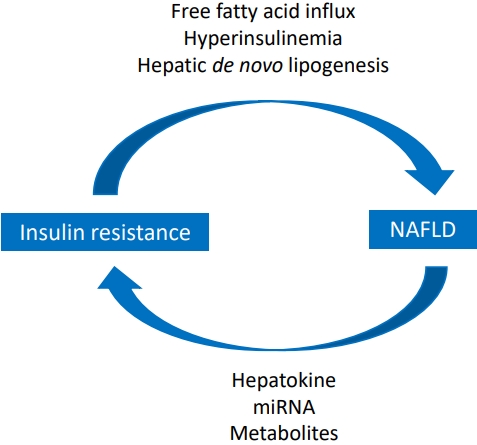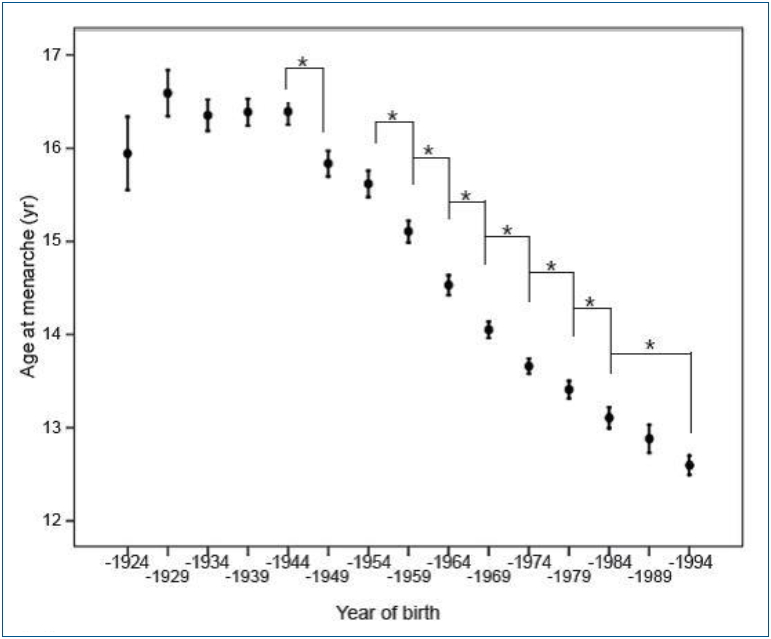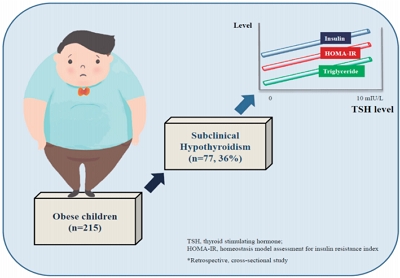Search
- Page Path
-
- HOME
- Search
- Original Article
- Adolescence Medicine
- Relationship between inflammatory biomarkers and insulin resistance in excess-weight Latin children
- Mariano Nicolás Aleman, María Constanza Luciardi, Emilce Romina Albornoz, María Cristina Bazán, Adela Victoria Abregú
- Clin Exp Pediatr. 2024;67(1):37-45. Published online December 21, 2023
-

Question: What is the prevalence of insulin resistance (IR) in excess-weight Latin children, and can proinflammatory biomarkers predict it?
Finding: IR prevalence was elevated and tumor necrosis factor- α, interleukin-6, monocyte chemoattractant protein- 1, soluble CD40 ligand, and high-sensitivity C-reactive protein levels were increased in excess-weight Latin children. However, none predicted IR status.
Meaning: These inflammatory biomarkers were unable to predict IR status. Therefore, further investigations are necessary.
- Review Article
- General Pediatrics
- Metabolic complications of obesity in children and adolescents
- Hyunjin Park, Jung Eun Choi, Seunghee Jun, Hyelim Lee, Hae Soon Kim, Hye Ah Lee, Hyesook Park
- Clin Exp Pediatr. 2024;67(7):347-355. Published online November 16, 2023
-

· Pediatric obesity increases the risk of metabolic complications (insulin resistance, dyslipidemia, nonalcoholic fatty liver disease) and long-term cardiovascular diseases.
· A new obesity definition and various indicators (continuous metabolic syndrome score, pediatric simple metabolic syndrome score, fatty liver index) have been proposed to evaluate children’s susceptibility to metabolic disorders.
· Laboratory and body composition tests in pediatric screenings can identify groups at high risk of metabolic complications of obesity.
- Endocrinology
- Nonalcoholic fatty liver disease and insulin resistance in children
- Kyungchul Song, Ho-Seong Kim, Hyun Wook Chae
- Clin Exp Pediatr. 2023;66(12):512-519. Published online January 9, 2023
-

· The prevalence of pediatric nonalcoholic fatty liver disease (NAFLD) increased from 8.2% in 2009 to 12.1% in 2018 in Korea.
· Laboratory tests, biomarkers, and imaging studies are used for the early detection of NAFLD.
· Insulin resistance is closely related to NAFLD.
- Early menarche and its consequence in Korean female: reducing fructose intake could be one solution
- Ji Hyun Kim, Jung Sub Lim
- Clin Exp Pediatr. 2021;64(1):12-20. Published online May 14, 2020
-

In Korea, the average age of menarche has declined sharply. Early menarche is associated with psychosocial and behavioral problems and cardiometabolic disease. Excess fructose intake has been suggested as one cause of early menarche in recent studies, so reducing fructose intake may be one solution.
- Original Article
- Endocrinology
- Influence of subclinical hypothyroidism on metabolic parameters in obese children and adolescents
- Ozlem Kara
- Clin Exp Pediatr. 2020;63(3):110-114. Published online March 6, 2020
-

Question: Does subclinical hypothyroidism in obese children and adolescents affect metabolic parameters?
Finding: Insulin, HOMA-IR, and TG levels were higher and the HDL-C level was lower in patients with SH.
Meaning: A clear association is observed between SH, and insulin resistance and dyslipidemia in obese children. It can be said that the TSH may be evaluated as a metabolic risk factor in obese patients.
- Adolescence Medicine
- Serum alanine aminotransferase levels are closely associated with metabolic disturbances in apparently healthy young adolescents independent of obesity
- Ki Eun Kim, Kyung Suk Baek, Sol Han, Jung Hyun Kim, Youn Ho Shin
- Clin Exp Pediatr. 2019;62(2):48-54. Published online November 23, 2018
-

Purpose: Liver metabolism plays a pivotal role in the development of metabolic disorders. We aimed to investigate the clinical and laboratory risk factors associated with alanine aminotransferase (ALT) levels in young adolescents from an urban population in Korea. Methods: A population of 120 apparently healthy adolescents aged 12–13 years was included in the cross-sectional design study; 58 were overweight or obese...
- Endocrinology
- Lipopolysaccharide-binding protein plasma levels as a biomarker of obesity-related insulin resistance in adolescents
- Ki Eun Kim, Young Sun Cho, Kyung Suk Baek, Lan Li, Kwang-Hyun Baek, Jung Hyun Kim, Ho-Seong Kim, Youn Ho Sheen
- Clin Exp Pediatr. 2016;59(5):231-238. Published online May 31, 2016
-
Purpose Lipopolysaccharide-binding protein (LBP) is a 65-kDa acute phase protein, derived from the liver, which is present in high concentrations in plasma. Data regarding the association between circulating plasma LBP levels and obesity-related biomarkers in the pediatric population are scarce. We aimed to determine whether there was a difference in plasma LBP levels between overweight/obese and normal-weight adolescents and to assess...
- Review Article
- Endocrinology
- Catch-up growth and catch-up fat in children born small for gestational age
- Won Kyoung Cho, Byung-Kyu Suh
- Clin Exp Pediatr. 2016;59(1):1-7. Published online January 22, 2016
-
Infants born small for gestational age (SGA) are at increased risk of perinatal morbidity, persistent short stature, and metabolic alterations in later life. Recent studies have focused on the association between birth weight (BW) and later body composition. Some reports suggest that fetal nutrition, as reflected by BW, may have an inverse programing effect on abdominal adiposity later in life....
- Original Article
- Serum leptin, adiponectin and resistin levels in obese children and their correlations with insulin resistance
- Min Young Park, Sun A Ahn, Won Kyoung Cho, Kyoung Soon Cho, So Hyun Park, Seung Hoon Hahn, Min Ho Jung, Byung-Kyu Suh
- Clin Exp Pediatr. 2009;52(7):766-771. Published online July 15, 2009
-
Purpose : The objective of this study was to compare the levels of adipocytokines in obesity group with those in control group and examine their correlation with insulin resistance. Methods : We enrolled 36 obese children (male:female [M:F]=17:19; age, 9.3±1.9 yrs) with ≥95th percentile body mass indexes (BMIs) (obesity group) and 35 healthy children (M:F=16:19; age, 9.1±2.1 yrs) with 25th-75th percentile... -
- Development of metabolic syndrome and its correlation with insulin resistance in adult patients with Turner syndrome
- Joo Hwa Kim, Min Jae Kang, Choong Ho Shin, Sei Won Yang
- Clin Exp Pediatr. 2009;52(3):370-375. Published online March 15, 2009
-
Purpose : The risk of metabolic syndrome (MS) and cardiovascular disease in Turner syndrome (TS) patients is high. We analyzed metabolic factors in adults with TS and evaluated the metabolic risk of insulin resistance. Methods : Forty-three adults with TS were enrolled. The frequency of MS and the values of the metabolic factors were analyzed. Patients were divided into insulin... -
- Review Article
- Consequences of being born small for gestational age : More than being small
- Eun-Gyong Yoo
- Clin Exp Pediatr. 2009;52(2):152-158. Published online February 15, 2009
-
Reduced fetal growth is independently associated with increased risk of health problems in later life, particularly type 2 diabetes and cardiovascular diseases. Insulin resistance appears to be a key component underlying these metabolic complications. It is suggested that detrimental fetal environment may program insulin resistance syndrome. An insulin-resistant genotype may also result in both low birth weight and insulin resistance... -
- Original Article
- The relationship between leptin adiponectin ratio and insulin resistance in healthy children
- Gae-Hyun Ahn, Shin-Hye Kim, Eun-Gyong Yoo
- Clin Exp Pediatr. 2008;51(3):256-261. Published online March 15, 2008
-
Purpose : Leptin and adiponectin are two representative adipocytokines. Leptin increases, but adiponectin decreases, with obesity and insulin resistance. We aimed to study the relationship between the leptin/adiponectin ratio and insulin resistance in healthy children. Methods : Seventy-seven healthy children (36 boys and 41 girls) were enrolled in this study. Anthropometric measurements were performed, and the percentage of weight for... -
- Alteration of insulin resistance and serum adiponectin levels after one year follow-up of obese children and adolescents
- Min Jee Jeoung, Jung Yeon Shin, Soo Young Kim, Jung Hwa Lee, Kee-Hyoung Lee, Joo Won Lee
- Clin Exp Pediatr. 2007;50(8):767-773. Published online August 15, 2007
-
Purpose : Obesity has become a pandemic and especially the prevalence of childhood obesity has increased remarkably over the past years. Childhood obesity is often accompanied by the expected morbidities such as hyperlipidemia, fatty liver and glucose intolerance. We evaluated the pattern of alteration in the body mass index (BMI), serum adiponectin concentration, insulin resistance (HOMA-IR), and complication rates after... -
- Effects of growth hormone treatment on glucose metabolism in idiopathic short stature
- Seung Yeon Kwon, Duk-Hee Kim, Ho-Seong Kim
- Clin Exp Pediatr. 2006;49(6):665-671. Published online June 15, 2006
-
Purpose : To study the effects of growth hormone(GH) treatment on glucose metabolism and insulin resistance in children with idiopathic short stature(ISS). Methods : Glucose and insulin concentrations were measured during oral glucose tolerance test (OGTT) before and after GH treatment(0.6-0.7 IU/kg/week) in 20 patients with ISS. Insulin resistance was assessed by homeostasis model assessment(HOMA). Results : During OGTT, the mean... -
- Serum Ferritin as a Risk Factor in Type 2 Diabetes Mellitus
- Jung Hyun Kim, Ho Seong Kim, Duk Hee Kim
- Clin Exp Pediatr. 2005;48(11):1239-1243. Published online November 15, 2005
-
Purpose : Iron accumulation interferes with hepatic insulin extraction and affects insulin synthesis and secretion. The purpose of this study is to investigate the correlation between serum ferritin and type 2 diabetes mellitus. Methods : We compared the serum ferritin level among 18 patients in an impaired glucose tolerance (IGT) group, 36 in a type 1 diabetes group, eight in... -
- Serum Insulin, Insulin-like Growth Factor-I and Insulin-like Growth Factor Binding Protein-3 Levels in Obese Adolescents
- Jung Hyun Kwon, Hyun Jin Kim, Young Mi Hong
- Clin Exp Pediatr. 2005;48(11):1172-1178. Published online November 15, 2005
-
Purpose : Childhood Obesity is increasing throughout the world, and it is known to incur many diseases especially in later life such as diabetes and cardiovascular disorders. The purpose of this study was to investigate the association between obesity and insulin, insulin-like growth factor-I (IGF-I), insulin-like growth factor binding protein-3(IGFBP-3) and know if these factors are useful in predicting cardiovascular... -
- Affecting Factors of Insulin Resistance in Obese Children and Adolescents
- Duk Hee Kim, Ho Seon Eun, In Kyung Choi, Ho Seung Kim, Bong Soo Cha, Dong Kee Kim
- Clin Exp Pediatr. 2005;48(10):1076-1081. Published online October 15, 2005
-
Purpose : Insulin resistance is the most important risk factor linked to the development of impaired glucose tolerance(IGT), diabetes mellitus and cardiovascular diseases in childhood and adolescent obesity, The purpose of this study was to see whether insulin resistance of obese adolescent is higher than that of obese children. and to analyze gender difference and affecting factors of insulin resistance. Methods... -
- Serum Adiponectin Levels and Insulin Resistance in Obese Children
- Hee-Sun Lee, Jin Lee, Min-Joo Kang, Byung-Min Choi, Kee-Hyoung Lee
- Clin Exp Pediatr. 2005;48(5):481-487. Published online May 15, 2005
-
Purpose : Adiponectin, adipose tissue-specific protein, has anti-inflammatory and anti-atherogenic properties. It has been found to have a negative correlation with obesity and to play a role in modulating glucose tolerance and insulin sensitivity. Serum adiponectin concentrations are decreased in adults with obesity and type 2 diabetes. We investigated the difference in adiponectin levels between obese and non-obese children, and... -
- Prevalence of the Nonalcoholic Fatty Liver Disease in Obese Children
- Sung Woog Hwang, Duk Hee Kim, Ho Seong Kim
- Clin Exp Pediatr. 2005;48(1):13-20. Published online January 15, 2005
-
Purpose : Obesity is, along with metabolic syndrome, closely related with nonalcoholic fatty liver disease. This study tried to evaluate the prevalence of nonalcoholic liver disease in obese children and verify the factors associated with the disease. Methods : Two hundred and seventy nine children who showed a body mass index of 95 percentile over the baseline in health examinations... -
- Prevalence of Metabolic Syndrome in Obese Children
- Jin Ha Chang, Duk Hee Kim, Ho-Seong Kim, In Kyoung Choi, My Young Cheong, Dong Kee Kim
- Clin Exp Pediatr. 2004;47(11):1149-1156. Published online November 15, 2004
-
Purpose : Obesity has been known to be a cause of insulin resistance and dyslipidemia, and along with coronary artery disease and diabetes, is associated with metabolic syndrome(MS). This study aimed to ascertain the cause and prevalence of MS in obese children and adolescents. Methods : Two hundred and seventy-seven school children, who showed more than a 95th percentile of body... -
-

-
-

-

-
Impact Factor3.2
-
8.02023CiteScore94nd percentilePowered by







